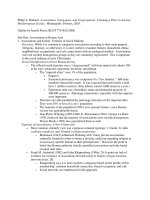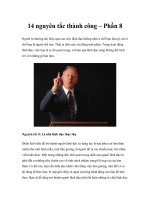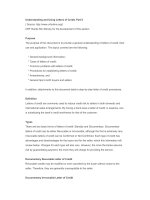Tài liệu Golf and the game of leadership 8 pptx
Bạn đang xem bản rút gọn của tài liệu. Xem và tải ngay bản đầy đủ của tài liệu tại đây (222.55 KB, 10 trang )
60
Golf and the Game of Leadership
‘‘Well, you see the glass windows all around this booth? The
sun comes in and heats this place like an oven.’’ (As he
spoke, the operator took a handkerchief out of his pocket
and wiped the perspiration from his face.) ‘‘Now, I’ve told
my boss and sent four memos to management asking for
some blinds for these windows, and maybe a fan, and
haven’t gotten the first response. The way I figure it, when
someone talks to me about the blinds and the fan, I’ll tell
them about the brakes!’’
The tank commander and the switching-yard operator had
gotten the wrong message about vision and value, courtesy of
management. Leaders must align with stated visions and values
and reinforce them with their daily decisions. That’s the bottom
line.
Something Significant Yet to Do
Viktor Frankl, in his classic work about survival in the World War
II Nazi concentration camps, Man’s Search for Meaning, writes
that those who survived shared one common focus, each had
‘‘something significant yet to do in the future.’’
3
They had a vision.
The leader needs that kind of direction and so do his or her fol-
lowers. Frankl not only survived Auschwitz, he became, along
with Freud and Adler, the most famous of the Viennese psycho-
therapists. Man’s Search for Meaning sold more than 2 million
copies, is in its seventy-third edition, and has been translated into
twenty-six languages. Victor Frankl is not likely to be soon for-
gotten.
According to Frankl, mental health is about looking forward,
not backward, and about finding purpose in life. It is about having
a positive vision of the future. Frankl lived on his visions long
after relying on them to give him the mental strength to survive
Auschwitz. He died a few years ago at age 92.
There are many stories of people surviving the most difficult
of circumstances by visualizing those things having significant
10589$ $CH5 02-23-04 16:44:42 PS
61
Tee It Up with Vision
meaning to them. One such story involved an American prisoner
of war during the Korean War, who was imprisoned for more
than five years. One of his avocations before his capture was the
game of golf. In fact, he was a very good player, a scratch golfer.
Finally, he was released from captivity and, as you would expect,
he spent several months going through a rehabilitation process to
regain his health and strength. At the very first opportunity, he
played a round of golf. He shot 74. His partners were amazed and
asked him how he had been able to do so well. And he told them,
‘‘It wasn’t hard at all. I’ve been playing today’s round every day
for the past five years!’’
A ‘‘visioning technique’’ that some people use is to write the
speech they would like to hear at their retirement party, or per-
haps to write their own obituary. The purpose is to capture the
vision of future successes that the person will then strive to ac-
complish.
Finally, you need to ensure that your visualizations are realis-
tic and doable. If they are not, change them to what is doable,
with a stretch, and maintain a positive, optimistic view of the
future.
Winston Churchill, one of my favorite historical leaders, was
literally an ‘‘eternal optimist’’ who held positive visions of the
future. He prescribed his own funeral arrangements, which were
followed at his actual funeral service at London’s St. Paul’s Cathe-
dral. There were two buglers, located at opposite ends of the
church. At the close of the ceremony, the first bugler, at the front
of the church, played ‘‘Taps.’’ Just before he finished, and as
Churchill’s casket reached the doors of the church, the second
bugler began to play ‘‘Reveille.’’
Why is it the ship beats the waves when the waves are
so many and the ship is one? The reason is that the ship
has a purpose.
Winston Churchill
10589$ $CH5 02-23-04 16:44:42 PS
62
Golf and the Game of Leadership
Quick Tips for Improving Your Leadership
Game
Real leaders typically understand and model the following in their
day-to-day actions:
■
Explain the organization’s vision to your associates in your
own words without reference to the vision document and
translate it into day-to-day actions related to your leader-
ship responsibilities.
■
Use the components of the vision as key criteria in assessing
alternatives, in making decisions, and in challenging ac-
tions, or lack of action, not consistent with the vision.
■
A lesson from Noah’s Ark: Build your future on high
ground.
10589$ $CH5 02-23-04 16:44:43 PS
5
6
Posture, Grip, Alignment
(PGA)
To get an elementary grasp of the game of golf, a
human must learn, by endless practice, a continuous
and subtle series of highly unnatural movements
involving about sixty-four muscles, that result in a
seemingly ‘‘natural swing,’’ taking all of two seconds to
begin and end.
1
Alistair Cooke, British journalist
Effective leadership starts with a strong foundation. We’ve dis-
cussed three of the four corners essential to your leadership foun-
dation. On hole ࠻3, we talked about policies and practices that
reflect the values of the organization and the importance of your
personal values. As we teed up on the next hole, we stressed the
need to play by the rules of ethics, honor, and organizational stan-
63
10589$ $CH6 02-23-04 16:44:40 PS
64
Golf and the Game of Leadership
dards. And on the hole we just played, we discussed the necessity
for you and your followers to be able to pursue a vision that
provides a clear, over-arching direction to your leadership activity
and their efforts.
Each of these requirements for play is found in both the game
of golf and the game of leadership. Hopefully, as we have played
these holes you’ve identified any deficiencies that you need to ad-
dress. Even more hopefully, you feel good about where you stand
on values, rules, and vision. I know you are itching to make im-
provements as we continue the round, but first we need to con-
sider the fourth corner of our foundation.
The game of golf relies on the effective application of posture,
grip, and alignment, which means properly setting up to effec-
tively swing the club and play the game. A myriad of seemingly
different applications of these elements can be observed as we
watch golf on television or observe other players as we play our
local courses. Some work well, others do not. And, it is easy to
tell what works and what doesn’t, because the results are clearly
observable to all. Those results are traceable to whether or not
there is appropriate application of the fundamentals of posture,
grip, and alignment. I know you’ve observed the acronym, PGA.
Posture, grip, and alignment combine to provide the golfer
with the proper setup for playing the game. On this hole let’s
examine how the golfer prepares to swing effectively and compare
that to what you as a leader need to do in final preparation for
swinging the leadership club. It is probably not necessary to get as
basic as UCLA’s basketball coaching great, John Wooden, who is
reported to have taught his players how to play the game by first
teaching them how to lace up and tie their shoes. But it is neces-
sary for you to feel comfortable with your leadership footing.
Posture (A Realistic Stance)
The revered golfing figure, Bobby Jones, once commented, ‘‘The
general criticisms which are to be made of the average player’s
posture at address are that his feet are too far apart, his body is
bent too much, and his arms are extended too far.’’
2
Posture to
10589$ $CH6 02-23-04 16:44:41 PS
65
Posture, Grip, Alignment (PGA)
the golfer means the proper positioning of the various body parts
for comfort, leverage, and ease of swing. The golfer wants to be
sure of a solid base to work from, and so positioning is very im-
portant. The fundamentals of correct golfing posture involve
slightly bending the knees, a forward tilt at the hips, a straight
back, and body weight evenly distributed between the toes and
balls of the feet. The purpose is to establish a realistically sound
athletic approach to the golf stance. Leaders need to develop a
realistic stance regarding their leadership play on the Global Lead-
ership Course.
A realistic stance for the leader must consider a variety of
elements. How are you positioning yourself as a leader in the or-
ganization? What direction is the organization heading? What are
the requirements for success in running your business today, to-
morrow, and the day after tomorrow? What do you see as your
role in helping to lead the organization? Is it the need to be a
dynamic leader, a tough-minded boss, a developmental mentor
and coach, a turn-around expert, a consensus builder, a micro-
manager, or a facilitator? Have you made the diagnosis and veri-
fied it so that your leadership posture fits the demands of the
situation you have been assigned? Is your organization playing in
the fairway, out of the rough, on the upslope of growth or the
downslope of down-sizing? Wow! Yes, you have to do this analysis
of your business and organization setting before expecting to play
the leadership game effectively.
Success at golf, leadership, or any endeavor of substance re-
quires that we understand and play within the realities of the envi-
ronment. Golfers understand this, and the good ones pursue a
well-thought-out course management strategy, which includes
consideration of the layout of each hole on the golf course. Dis-
tance, slope, rough, width of fairways, location of water hazards
and sand traps, and pin placements are all considered. Then ad-
justments are made to respond to the vagaries of the weather and
the potential effect of wind, rain, early morning dew, afternoon
drying-out, and so on. Course management is serious business to
the wise golfer. It is part of posturing to play the golf course.
Similarly, understanding the leadership course environment
10589$ $CH6 02-23-04 16:44:41 PS
66
Golf and the Game of Leadership
is serious business for the wise leader. The twenty-first century
already is, and promises to continue to be, one of great complexity
and challenge. You need a sound and realistic view of the overall
situational environment to play the leadership game. The Global
Leadership Course is one tough layout!
The Leadership Environment
At one of the previously mentioned ‘‘Leadership NOW’’ (L-
NOW) sessions I conducted within General Motors, I had the
pleasure of meeting and working with Bob Dorn, then chief engi-
neer for GM’s Cadillac Division. Bob was a highly respected engi-
neer, a great person, and a real leader. I vividly remember his
taking over an L-NOW session one afternoon. He politely asked
the facilitators to hand over the chart pads and marking pens, and
to find a comfortable seat. Bob then proceeded to present his
fellow leaders, and yours truly, a fundamental lesson regarding the
leadership environment for then and for the foreseeable future.
Bob was a student of military history. He began his conversa-
tion by drawing on a chart pad an organizational pyramid and the
communication/information flow arrows for a hierarchical orga-
nization such as GM. As shown in Figure 6-1, the dominating big
arrow moves from top to bottom, and a set of small arrows moves
from the bottom to the top. GM was, and historically had been, a
model for the top-down hierarchical organization. Top leaders
provided vision, values, and strategies, and they were supported
by middle management, first-line supervision, and hundreds of
thousands of front-line workers.
On another chart pad, Bob then drew a pyramid similar to
the one in Figure 6-1. He drew the same set of arrows on the
second pyramid but labeled the organization as the U.S. Marine
Corps. Bob pointed out that GM and the military were the classic
models of hierarchical organization structure taught in colleges
and universities. In Figure 6-2 we see the vision, values, and strate-
gies of the generals and top brass, supported by officers, noncom-
missioned officers, and front-line marines.
But, Bob wasn’t done. On a third chart pad, he drew yet an-
10589$ $CH6 02-23-04 16:44:41 PS
67
Posture, Grip, Alignment (PGA)
FIGURE 6-1.
Corporate communication flow: General Motors.
Vision/Values/Strategy
Chairman/CEO/Top Management
Middle Management
First-Line Supervision
Front-Line Workers
FIGURE 6-2.
Peacetime military communication flow: U.S. Marine Corps.
Vision/Values/Strategy
Generals/Top Brass
Senior Officers
Front-Line Junior Officers
/
Noncommissioned Officers
Front-Line Troops
10589$ $CH6 02-23-04 16:44:44 PS
68
Golf and the Game of Leadership
other illustration. This drawing, shown in Figure 6-3, is an in-
verted pyramid, with the Marine Corps hierarchy also inverted.
But here the communication arrows point in the same direction
as in Figures 6-1 and 6-2.
Bob then commented that the Marine Corps always responds
to the environment. Figure 6-2, he explained, represents the Ma-
rine Corps functioning in an environment of peace—much the
same as a GM or other business organization operates in a period
of industry dominance. Figure 6-3 is the Marine Corps operating
in a wartime environment.
In peacetime, the Marine Corps’ generals and top leadership
are able to dominate the communication flow and survive, much
the same as a GM could when the competition was not strong and
customers were satisfied. In wartime, the pyramid flips, and suc-
cess in battle, meaning survival and victory, depends on the com-
munication flow from platoon leaders and noncommissioned
FIGURE 6-3.
Wartime military communication flow: U.S. Marine Corps.
Vision/Values/Strategy
Generals/Top Brass
Senior Officers
Front-Line Junior Officers/
Noncommissioned Officers
Front-Line Troops
10589$ $CH6 02-23-04 16:44:45 PS
69
Posture, Grip, Alignment (PGA)
officers (NCOs) at the forward edge of the battle area (FEBA),
and the responsive support of the leadership up the line. In short,
survival and victory depend on the recognition that in war, leader-
ship’s role is to provide the support necessary for the front-line
warriors to win the fire fights, the battles, and the war.
And then, Bob Dorn asked this question, ‘‘Is GM at war or at
peace?’’
It has been fifteen years since Bob Dorn delivered his lesson.
I will leave it to you to judge the truth of his lesson today. For my
part, the lesson is even more meaningful now. We need leaders
who recognize that there is global competition in virtually every
form of enterprise. That is the reality you face, today and in the
future. Leaders need to view their role, not as one of power and
authority, but as one of service and support. The main mission is
to ensure that front-line workers receive the support necessary to
succeed. As Winston Churchill said, ‘‘Support is the long green
stem without which the bright flower of victory cannot bloom.’’
And he added, ‘‘For without victory there is no survival.’’
Making the Cut
When leaders are asked the question, ‘‘What is the goal of a capi-
talist enterprise?’’ the answers are usually ‘‘to make money,’’ ‘‘to
reward the stockholders,’’ or ‘‘to grow the business.’’ Few, very
few, respond as did John Smale, former CEO of Procter and Gam-
ble and then chairman of GM’s board, in a 1996 Fortune magazine
article about the future of General Motors:
A large capitalist enterprise must also be about higher goals
than merely serving stockholders. A corporation is a human
enterprise. It’s not just a bunch of assets. The obligation of
management is to perpetuate the corporation, which precedes
their obligation to shareholders.
3
Professional golf is also about survival. Only those ‘‘making
the cut’’ get a pay day. The reality of organization life is that effec-
tive leadership is a must for ‘‘making the cut’’: achieving success
and a long-term existence. This requires a solid grip on reality.
10589$ $CH6 02-23-04 16:44:45 PS









